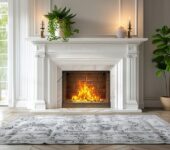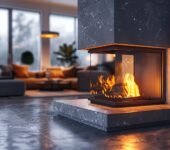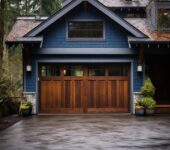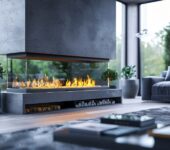Table of Contents
Fireplaces are a cozy addition to any home, but there are several common problems that can arise. These include everything from drafting problems to creosote buildup, damaged chimneys, and inadequate ventilation.
In this article, we will explore the various issues that can affect fireplaces and how they can be diagnosed. We will also discuss the solutions available to address these issues, such as cleaning and maintenance, chimney repair or replacement, and upgrading to a more efficient fireplace.
Let’s dive in and learn more about how to keep your fireplace in top shape.
What Is a Fireplace?
A fireplace is a structure designed to contain a fire safely and provide heat to a home, often located in the living room or family room.
Fireplaces come in various types, such as traditional wood-burning, gas, electric, and ethanol fireplaces, each offering unique features to suit different preferences and needs. Wood-burning fireplaces provide a classic ambiance and crackling sounds, while gas and electric fireplaces offer convenience and ease of use.
Proper maintenance is crucial to ensure the safe and efficient functioning of any fireplace. Regular cleaning of the chimney, checking for any obstructions, and ensuring proper ventilation are key practices to prevent hazards such as carbon monoxide buildup and chimney fires.
What Are the Common Problems with Fireplaces?
Fireplaces can experience common problems such as drafting issues, creosote buildup, damaged chimneys or flues, inadequate ventilation, and safety concerns like smoke and carbon monoxide exposure.
- Drafting issues can occur when there is an improper flow of air in and out of the fireplace, leading to smoke entering the room rather than being carried up the chimney.
- Creosote buildup, a byproduct of burning wood, can accumulate in the chimney and pose a fire hazard if not regularly cleaned.
- Damage to chimneys or flues can result from age, weather damage, or lack of maintenance, potentially leading to structural issues or dangerous leaks.
- Inadequate ventilation can trap harmful gases like carbon monoxide indoors, posing serious health risks to occupants.
Drafting Issues
Drafting issues in a fireplace can lead to smoke entering the room, insufficient airflow causing poor combustion, and the risk of backdrafts that can push smoke back into the home.
These drafting issues not only impact the comfort and safety of your living space but also affect the efficiency of your fireplace. Symptoms of draft problems can include difficulty lighting a fire, a smoky odor lingering in the house, or even visible smoke escaping into the room.
Causes of poor draft include blocked chimney flues, improper venting systems, or insufficient air supply. To address these issues, regular chimney inspections, proper ventilation maintenance, and ensuring a clear path for airflow are key steps in maintaining optimal fireplace performance.
Creosote Buildup
Creosote buildup, a byproduct of burning wood, can accumulate in the chimney, leading to blockages, increased fire hazards, and the potential for chimney fires.
It is crucial to regularly inspect and clean your chimney to mitigate these risks. One effective method for prevention is to ensure proper ventilation when burning wood, as inadequate airflow can contribute to creosote buildup. Using seasoned wood can help reduce the formation of creosote.
To detect creosote buildup, look for signs such as a strong burning odor or dark, tar-like substance on the chimney walls. Professional chimney sweeps utilize specialized tools to safely remove creosote, ensuring optimal fire safety in your home.
Damaged Chimney or Flue
A damaged chimney or flue, such as a cracked chimney liner or improper installation, can pose serious safety risks, including carbon monoxide exposure, smoke stains, and fire hazards.
These issues can often go unnoticed, as chimneys are not frequently inspected. To identify potential problems, homeowners should look out for signs such as water leaks, soot buildup, or strange odors. Addressing these warning signals promptly is crucial to prevent further damage and ensure the safety of occupants.
Professional chimney inspections and repairs by certified technicians are essential to maintain proper ventilation and prevent any potential dangers. Neglecting chimney maintenance can lead to structural issues, reduced energy efficiency, and even health risks.
Inadequate Ventilation
Inadequate ventilation in a fireplace can lead to drafty conditions, restricted airflow, and heating inefficiency, impacting the overall performance of the heating system and indoor air quality.
This lack of proper airflow not only affects the efficiency of the heating system but also contributes to poor indoor air quality, as stagnant air can trap pollutants and irritants.
Signs of inadequate ventilation include excessive smoke buildup, difficulty in lighting fires, and a lingering smoky smell in the house.
To improve ventilation efficiency, it is essential to regularly clean the chimney, ensure proper sizing of the flue, and consider installing a vent fan or air intake to enhance airflow and energy efficiency.
Obstructions in the Chimney
Blockages or obstructions in the chimney can hinder proper ventilation, increase the risk of carbon monoxide buildup, and contribute to draft problems and smoke issues.
Regular chimney maintenance and inspections play a crucial role in identifying and clearing any obstructions that may pose a threat to fireplace safety. Proper cleaning methods, such as using chimney brushes and rods, can help remove accumulated soot, debris, or animal nests that could block the flue and venting system. Ignoring these blockages can lead to dangerous situations, including chimney fires and health risks from toxic gases. By staying vigilant and proactive in maintaining clear chimneys, homeowners can ensure a safer and more efficient operation of their fireplaces.
Cracked or Damaged Firebox
A cracked or damaged firebox can present fire hazards, smoke leakage, and inefficient heat output, requiring timely repairs to ensure safe and effective fireplace operation.
If left unaddressed, issues with the firebox can escalate, potentially leading to more extensive damage of the fireplace structure. This can not only compromise the safety of your home but also result in increased energy bills due to heat loss.
To address these concerns, it is crucial to either repair the firebox using suitable refractory materials or opt for a replacement if the damage is severe. Regular maintenance practices, such as cleaning out ash and soot buildup, inspecting for cracks, and ensuring proper ventilation, are key to preserving the integrity of the firebox and ensuring optimal heating efficiency while safeguarding against potential safety risks.
Issues with Gas or Electric Fireplaces
Gas leaks in gas fireplaces and electrical malfunctions in electric fireplaces can pose significant safety risks, including fire hazards, carbon monoxide exposure, and potential damage to the heating system.
Regular maintenance and safety precautions are essential for both gas and electric fireplaces to ensure their proper functioning and longevity. Gas fireplaces should be inspected annually by a certified technician to check for leaks, blockages, and ensure the pilot light is functioning correctly. It is crucial to have carbon monoxide detectors installed near gas fireplaces to detect any leaks promptly. On the other hand, electric fireplaces require regular cleaning and checks on the electrical components to prevent malfunctions or overheating. Professional inspections play a vital role in detecting potential issues early and addressing them before they become hazardous.
How Can These Problems Be Diagnosed?
Diagnosing fireplace problems involves visual inspections, chimney sweeps, and the use of carbon monoxide detectors to identify issues and ensure the safety and efficiency of the fireplace.
Professional inspections by Dreifuss play a crucial role in accurately pinpointing any underlying issues that may not be visible during a routine check. These inspections are carried out by certified technicians who have the expertise to assess the condition of the fireplace and its components thoroughly.
Regular maintenance checks are essential to address problems effectively before they escalate into major issues that could pose safety risks. By conducting these checks periodically, homeowners can ensure that their fireplace functions optimally and safely throughout the year.
Visual Inspection
Visual inspections of the fireplace can reveal signs of smoke stains, sparks, or other visible issues that may indicate underlying problems affecting the fireplace’s performance and safety.
During the inspection, it is crucial to closely examine the chimney for any creosote buildup, as this highly flammable substance can pose a significant fire hazard.
Checking the integrity of the fireplace doors, screens, and seals is essential to ensure proper ventilation and prevent any smoke leakage into the living space.
Inspecting the hearth and surrounding area for cracks, loose bricks, or signs of water damage is also important in maintaining the overall structural stability of the fireplace and preventing potential safety risks.
Chimney Sweep and Inspection
Regular chimney sweeps and inspections are essential for ensuring proper venting, removing creosote buildup, and maintaining the chimney’s structural integrity to prevent fire hazards and ensure efficient ventilation.
Chimney sweeps play a crucial role in maintaining the safety of your home by thoroughly cleaning out soot, debris, and other potential blockages that could restrict airflow and lead to dangerous situations. By regularly scheduling inspections, homeowners can catch any issues early on, preventing costly repairs and ensuring that the chimney functions effectively.
Proper venting is also vital to prevent carbon monoxide buildup and ensure that smoke is safely directed outside. Neglecting chimney maintenance can result in not only fire hazards but also poor indoor air quality and ventilation issues.
Carbon Monoxide Detector
Carbon monoxide detectors are crucial for monitoring indoor air quality, detecting potential leaks or buildup, and ensuring the safe operation of fireplaces to prevent carbon monoxide poisoning.
Early detection provided by these detectors can alert you to any dangerous levels of carbon monoxide in your home, which is odorless and colorless, making it impossible to detect without specialized equipment.
Regular maintenance of carbon monoxide detectors is essential to ensure they are functioning properly and continuously monitoring for any harmful gases, giving you peace of mind and keeping your family safe from potential health risks.
What Are the Solutions to These Problems?
Solutions to fireplace problems include regular cleaning and maintenance, and chimney repairs or replacements. Solutions also include installing chimney caps, and upgrading to more efficient fireplace models. This will enhance safety and performance.
One crucial aspect of fireplace maintenance is ensuring proper ventilation. This will prevent the build-up of harmful gases like carbon monoxide. It’s also essential to regularly inspect the flue and chimney for any blockages or damage. These can pose a fire hazard. Using seasoned hardwood for burning can help reduce creosote accumulation in the chimney. Adjusting the damper and ensuring proper air circulation can make a significant difference in the fireplace’s efficiency. This is the case for homeowners facing issues with draft or smoke in the room.
Dreifuss is your go to company for fireplace repair and maintenance. Contact Dreifuss to schedule today.
Cleaning and Maintenance
Regular cleaning and maintenance routines are essential for removing soot accumulation. This prevents blockages, and ensures optimal performance and safety of the fireplace.
To effectively clean a fireplace, it is recommended to schedule a thorough cleaning at least once a year, ideally before the start of the burning season. This includes removing ashes and debris from the firebox, checking for any obstructions in the chimney, and inspecting the venting system for any signs of damage.
To reduce creosote buildup, it is important to burn only well-seasoned hardwoods and avoid burning trash or treated wood, which can contribute to increased residue. Ensuring that hearth accessories such as screens and tools are clean and properly stored can also enhance the overall aesthetics and functionality of the fireplace.
Chimney Repair or Replacement
Chimney repairs or replacements are necessary for addressing structural damage, cracks, or blockages. These issues compromise the chimney’s integrity and safety. Repairs ensure proper venting and prevent fire hazards.
These issues can arise due to wear and tear over time, weather exposure, or lack of maintenance. It is crucial to tackle these problems promptly to avoid more extensive damage and costly repairs down the line. Professional chimney services play a vital role in inspecting, identifying, and resolving such issues efficiently. They have the expertise and tools required to carry out repairs or replacements effectively. This ensures that your fireplace operates safely and efficiently.
Ignoring chimney problems can lead to serious consequences. Therefore, it’s important to prioritize regular maintenance and repairs to enjoy a warm and safe fireplace experience.
Installing a Chimney Cap
Installing a chimney cap can prevent debris, animals, and moisture from entering the chimney. This reduces fire hazards, blockages, and improves overall ventilation efficiency.
In addition, chimney caps also play a crucial role in protecting the chimney structure itself by acting as vent covers. The cap helps to prevent water damage and deterioration over time. This occurs by shielding the chimney opening from rain, snow, and debris. The installation of a chimney cap can significantly reduce the risk of drafting issues. These issues can lead to smoke entering your home and affecting indoor air quality. Ensuring that your chimney is properly capped is essential to maintaining the integrity of your chimney. This helps to prevent common issues, and enhances safety.
Upgrading to a More Efficient Fireplace
Upgrading to a more efficient fireplace model can enhance heating performance, and reduce energy consumption. In addition, it can lower carbon footprint, improving indoor air quality and overall heating system efficiency.
When considering a new fireplace model, it’s important to look for extra features. These features include programmable thermostats, adjustable flame settings, and proper insulation to maximize heat retention. These features not only provide customizable comfort but also contribute to significant energy savings over time. By investing in an energy-efficient fireplace, homeowners can not only save on heating costs. They also contribute to a healthier environment by reducing greenhouse gas emissions and promoting sustainable living practices.
Frequently Asked Questions
1. What is a fireplace?
A fireplace is a structure within a home designed to contain and safely manage a fire. In addition, it provides heat and often serves as a decorative focal point.
2. What are common problems with fireplaces?
Common issues include drafting problems, creosote buildup, and damaged chimneys or flues. Also, issues are inadequate ventilation, and safety concerns related to smoke and carbon monoxide.
3. How can drafting issues in a fireplace be addressed?
To solve drafting problems, ensure the chimney is clear of obstructions. In addition, make sure the flue is open, and there’s adequate air supply to support combustion.
4. What is creosote, and why is it a problem?
Creosote is a flammable residue from burning wood that can accumulate in chimneys, increasing the risk of chimney fires. Regular chimney cleaning can prevent creosote buildup.
5. How can inadequate ventilation in fireplaces be improved?
To improve ventilation, you can ensure that nothing is blocking the chimney. Also, using the correct size and type of venting system, and possibly installing additional air intake solutions.
6. What are some solutions to fireplace problems?
Solutions include regular cleaning and maintenance, and chimney repair or replacement. In addition, installing chimney caps to prevent blockages, and upgrading to more efficient fireplace models.
Latest Articles

What Is Fireplace Over-Firing?
Table of Contents1 What Is Fireplace Over-Firing?2 What Causes a Fireplace to Over-Fire?3 What Are the Signs of Over-Firing?4 What Are the Dangers of Over-Firing?5

What Type Of Fireplace Is Most Efficient?
Table of Contents1 Factors to Consider When Choosing a Fireplace2 Types of Fireplaces3 Which Type of Fireplace is the Most Efficient?4 Other Factors to Consider

How a Fireplace Flue Damper Can Improve Your Heating Efficiency
Table of Contents1 What is a Fireplace Flue Damper?2 How Does a Fireplace Flue Damper Work?3 What are the Benefits of Using a Fireplace Flue



















































































